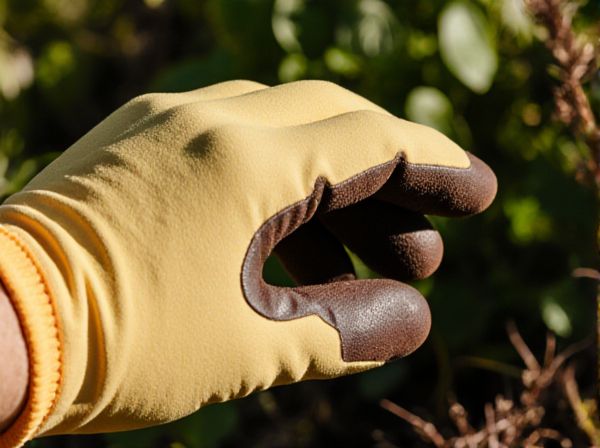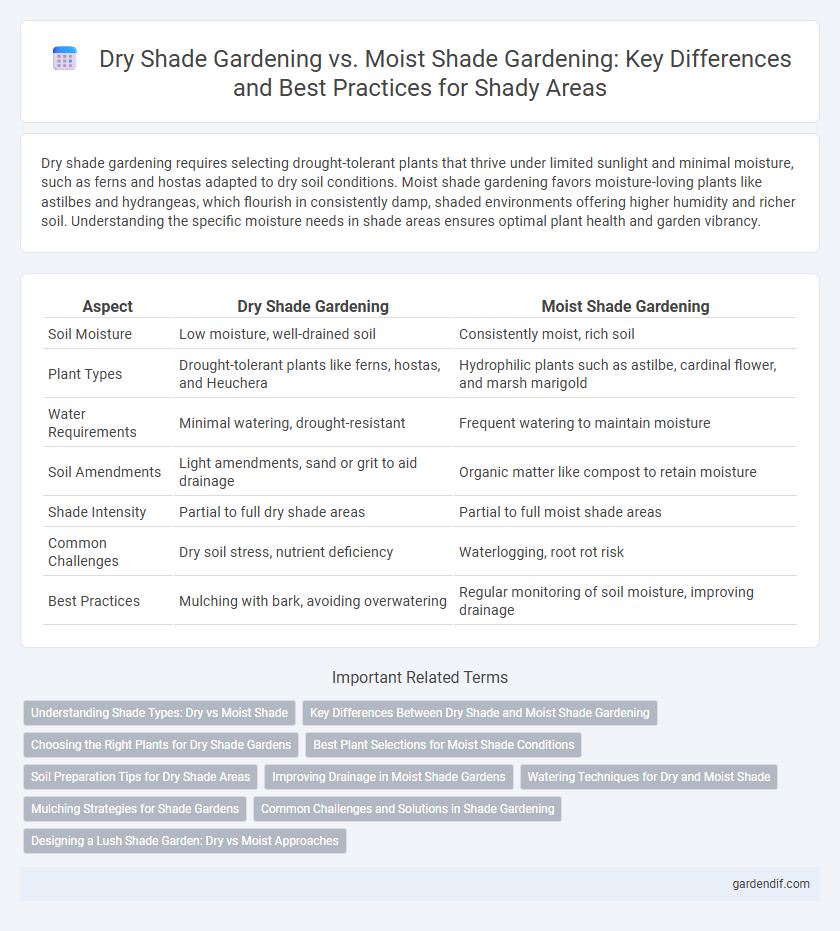
dry shade gardening vs moist shade gardening Illustration
Dry shade gardening requires selecting drought-tolerant plants that thrive under limited sunlight and minimal moisture, such as ferns and hostas adapted to dry soil conditions. Moist shade gardening favors moisture-loving plants like astilbes and hydrangeas, which flourish in consistently damp, shaded environments offering higher humidity and richer soil. Understanding the specific moisture needs in shade areas ensures optimal plant health and garden vibrancy.
Table of Comparison
| Aspect | Dry Shade Gardening | Moist Shade Gardening |
|---|---|---|
| Soil Moisture | Low moisture, well-drained soil | Consistently moist, rich soil |
| Plant Types | Drought-tolerant plants like ferns, hostas, and Heuchera | Hydrophilic plants such as astilbe, cardinal flower, and marsh marigold |
| Water Requirements | Minimal watering, drought-resistant | Frequent watering to maintain moisture |
| Soil Amendments | Light amendments, sand or grit to aid drainage | Organic matter like compost to retain moisture |
| Shade Intensity | Partial to full dry shade areas | Partial to full moist shade areas |
| Common Challenges | Dry soil stress, nutrient deficiency | Waterlogging, root rot risk |
| Best Practices | Mulching with bark, avoiding overwatering | Regular monitoring of soil moisture, improving drainage |
Understanding Shade Types: Dry vs Moist Shade
Dry shade gardening typically occurs under trees with minimal moisture retention, requiring plants adapted to low water and high drainage conditions. Moist shade gardening thrives in areas with consistent soil moisture, often shaded by dense foliage or near water sources, supporting plants that prefer damp, humid environments. Understanding the distinction between dry shade and moist shade is crucial for selecting appropriate plant species and ensuring successful garden growth.
Key Differences Between Dry Shade and Moist Shade Gardening
Dry shade gardening requires selecting drought-tolerant plants such as lavender, sedum, and hostas that thrive with minimal water and well-drained soil. Moist shade gardening favors species like ferns, astilbes, and hydrangeas, which need consistently damp, nutrient-rich soil and higher humidity levels. Soil moisture availability and plant choice are the primary differentiators influencing garden design, maintenance, and plant health in these two shade gardening types.
Choosing the Right Plants for Dry Shade Gardens
Selecting plants for dry shade gardens requires prioritizing drought-tolerant species adapted to low moisture and limited sunlight conditions, such as ferns, hostas, and sedums. These plants possess deep root systems and thick leaves that minimize water loss, ensuring survival in dry shade environments. Proper soil preparation with organic matter enhances moisture retention, supporting the growth of resilient vegetation in dry shade gardens.
Best Plant Selections for Moist Shade Conditions
Best plant selections for moist shade conditions include hostas, ferns, astilbes, and ligularia, which thrive in consistently damp, low-light environments. These plants have adapted to retain moisture in shaded soils, promoting lush foliage and vibrant blooms. Selecting moisture-tolerant species prevents root rot and ensures healthy growth in damp shade gardens.
Soil Preparation Tips for Dry Shade Areas
In dry shade gardening, soil preparation is crucial for plant survival and growth; focus on improving soil structure by incorporating organic matter such as compost or leaf mold to enhance moisture retention. Loosening compacted soil promotes root penetration and water absorption, while applying a thick layer of mulch helps reduce evaporation and maintain consistent soil moisture. Selecting drought-tolerant plants adapted to dry shade conditions further supports a thriving garden ecosystem.
Improving Drainage in Moist Shade Gardens
Improving drainage in moist shade gardens involves incorporating organic matter such as compost or leaf mold to enhance soil structure and water absorption. Installing French drains or raised beds can help redirect excess water away from root zones, preventing waterlogging. Selecting shade-tolerant plants adapted to moist conditions ensures healthier growth and reduces stress caused by poor drainage.
Watering Techniques for Dry and Moist Shade
Watering techniques for dry shade gardening emphasize infrequent, deep irrigation to encourage drought tolerance and root resilience, typically applying water once every 7-14 days depending on soil type and weather conditions. Moist shade gardening requires consistent, shallow watering to maintain higher soil moisture levels, often necessitating watering 2-3 times per week with careful monitoring to prevent waterlogging and root rot. Efficient drip irrigation systems and mulch application are essential in both settings to optimize water retention and reduce evaporation.
Mulching Strategies for Shade Gardens
Mulching strategies for shade gardens vary significantly between dry shade and moist shade conditions to optimize soil moisture retention and plant health. In dry shade gardens, organic mulches such as shredded bark or pine needles help conserve limited moisture, regulate soil temperature, and improve soil structure without promoting excessive dampness that could encourage fungal growth. Conversely, moist shade gardens benefit from thicker layers of compost or leaf mulch that enhance soil fertility and drainage while preventing waterlogged conditions detrimental to shade-loving plants.
Common Challenges and Solutions in Shade Gardening
Dry shade gardening often struggles with poor soil moisture retention, leading to drought stress in shade-tolerant plants such as ferns and hostas. In contrast, moist shade gardening frequently encounters waterlogging issues, promoting root rot in species like astilbe and ligularia. Effective solutions include amending soil with organic matter to improve moisture balance and selecting plant varieties adapted specifically to dry or moist shade conditions.
Designing a Lush Shade Garden: Dry vs Moist Approaches
Designing a lush shade garden requires selecting plants suited to either dry shade or moist shade conditions, as soil moisture levels profoundly affect plant health and growth. Dry shade gardens thrive with drought-tolerant species like ferns, hostas, and heucheras, which adapt to minimal water and limited sunlight. Moist shade gardens support lush, moisture-loving plants such as astilbes, ligularias, and cardinal flowers, promoting vibrant foliage and blooms in consistently damp, shaded environments.
dry shade gardening vs moist shade gardening Infographic

 gardendif.com
gardendif.com